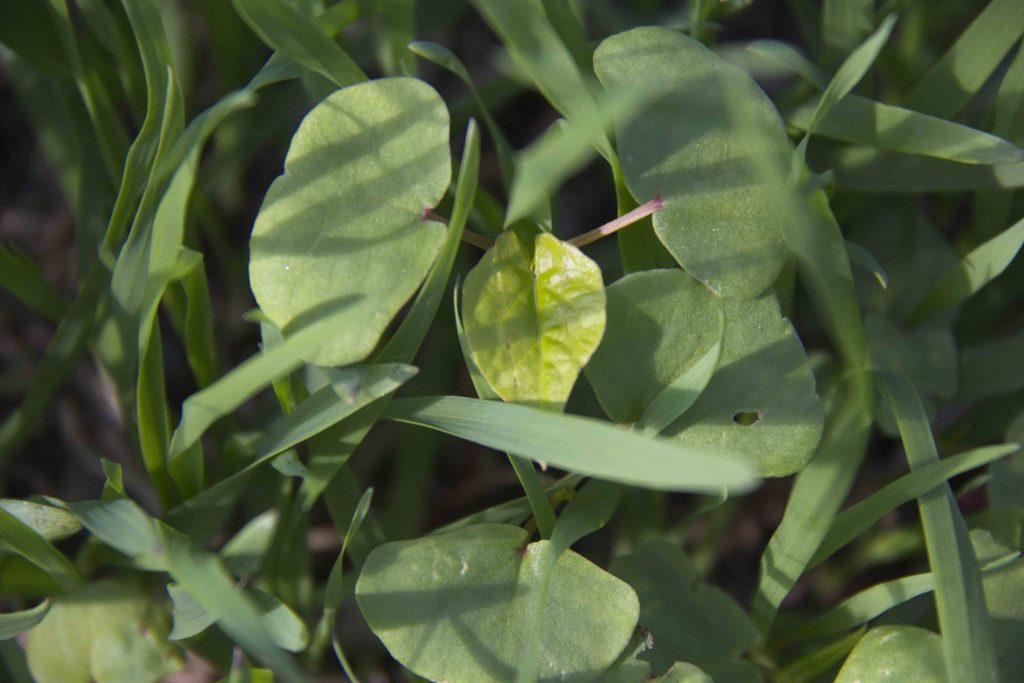
By Janet Wallace
Picture a flock of sheep on lush pasture. Now flip the image, as though you’re looking at a reflection in a still lake. Consider that there is likely an equal weight of life forms – plants, insects, other invertebrates and microorganisms – in the soil. Organic farmers don’t just take care of the plants and animals living on the soil surface, they also feed and protect soil life.
A healthy soil contains a staggering number of living organisms. A handful of healthy soil may contain more living beings than the global human population. These organisms are essential for the health of organic crops and livestock.
From mites to moles, earthworms to endophytes, there is a great diversity of creatures living in the soil. We will focus on microorganisms (e.g., bacteria, fungi, protozoa) and invertebrates (e.g., earthworms, nematodes, beetles).
The Leaders of the Underground #
Actinomycetes are bacteria that give soil its ‘earthy’ smell and leave thin filaments which contribute to soil aggregation. They aid in nutrient cycling, help control root disease by inhibiting pathogens, and promote plant growth regulators.
Arbuscular mycorrhizal fungi (AMF) are fungi with symbiotic (mutually beneficial) relationships with the roots of many plant species, other than Brassicas (e.g., canola, cabbage). AMF essentially increase the surface area of roots, which improves the ability of plants to extract water and nutrients, particularly phosphorus, from the soil. AMF also help protect plants from disease-causing fungi (including Fusarium and Pythium), harmful nematodes and other stresses, such as drought and extreme heat. AMF also improve soil structure.
Earthworms are an effective indicator species because they are simple to count and their abundance reflects overall soil health. Earthworms improve soil porosity and structure by creating tunnels, which allow air and water to infiltrate the soil, and lining these with nutrient-rich substances
Rhizobia are bacteria that live within the roots of legumes. They fix nitrogen from the air, which becomes available to other plants after nodules are shed from the roots of living legumes or when legumes are incorporated into the soil
Soil life is, in essence, the foundation of organic agriculture. Microorganisms and invertebrates help plants access nutrients and water, and protect plants from disease.


Contribution of Soil Life #
Soil life is, in essence, the foundation of organic agriculture. Microorganisms and invertebrates help plants access nutrients and water, and protect plants from disease. Organic Science Cluster (OSC) research has explored how farmers can protect soil life so the organisms can perform the following critical roles.
Decomposition
Many life forms are active decomposers. Insects and arthropods, like sowbugs, start the process followed by microorganisms. This demolition team releases nutrients contained in plant and animal material, including composted manure, cover crops and crop residue. Burrowing organisms (e.g., earthworms) help transport decomposing material and nutrients throughout the soil.
Nutrient cycling
In addition to releasing nutrients from decomposing organic matter, soil microorganisms also convert nutrients from minerals and gases into forms that plants can use. In nitrogen fixation, rhizobia capture nitrogen from the air; other (nitrifying) bacteria transform the ammonium to nitrite then to nitrates for plants to use. OSC researcher Dr. Chantal Hamel found that AMF seem to improve the capacity of host plants to use organic sources of P and N. She concludes that “AMF can extract soil nutrients and water efficiently, allowing good crop yields to be produced from soils with limited fertility.” When roots access more nutrients, the result can be healthier food. For example, in one study, OSC scientist Dr. Miranda Hart found that AMF-inoculated tomato plants had fruit with higher antioxidant capacity, higher nutrient quality and more carotenoids.
Carbon sequestration
As we face the climate crisis, researchers are investigating how carbon can be stored in the soil. Carbon sequestration is a complex, dynamic process in which soil life capture and transform carbon.
Improving soil tilth
Many lifeforms release substances that help soil particles stick together. Earthworm ‘slime,’ root secretions (exudates), fungal hyphae and bacterial filaments all contribute to soil aggregation and tilth. Also, tunnels created by burrowing organisms allow water (and air) to penetrate the soil.
Controlling Pests #
An abundant and diverse community of soil organisms provides strong protection against pests that may cause root disease. In soil with high biodiversity, beneficial microorganisms are much more common than harmful ones and can suppress disease-causing (pathogenic) organisms.
Protecting Soil Life #
Many common agricultural practices, such as tillage and the use of pesticides and synthetic fertilizers, can harm soil organisms. Fortunately, farmers can nourish and protect soil life by following many basic organic practices including:
• Use a diverse crop rotation including perennial crops or cover crops
• Avoid or minimize tillage
• Keep soil covered as much as possible with living crops or crop residue
• Use organic nutrient sources (green manures, composted manure) instead of synthetic fertilizers
• Avoid high levels of soil phosphorus
• Avoid the use of pesticides, including insecticides, biopesticides and herbicides
University of Manitoba’s Dr. Martin Entz has been involved in several OSC research activities, including investigating the longterm impact of organic field crop rotations on soil health. He found that crop rotations that include perennial (forage) crops improve soil health by increasing the size and activity of soil microbial populations. When forage or perennial green manure crops are grown, there is a thorough groundcover for all seasons and the soil is not disturbed by tillage or cultivation.
Tillage can injure soil invertebrates and damage their habitat by destroying tunnels and soil aggregates, which then reduces the infiltration of water and air into the soil. Microorganisms can also be affected. Entz found that tillage can decrease AM colonization and disrupt fungal networks.

Tillage can injure soil invertebrates and damage their habitat by destroying tunnels and soil aggregates, which then reduces the infiltration of water and air into the soil. Microorganisms can also be affected. Entz found that tillage can decrease AM colonization and disrupt fungal networks. However, Dr. Chantal Hamel found that soil microorganisms were more affected by the removal of crop residue than tillage. Hamel has been involved in various OSC activities with a focus on AMF. While cropresidue is a clearly visible food source for soil life, another food source is crop roots, which nourish soil organisms during the growing season and after harvest.
Removal of crop residue can be more disruptive than tillage because ground cover (crop residue, mulch or plants) provides habitat and moderates soil moisture and temperature. This is important because many soil organisms, particularly AMF, are sensitive to dryness, waterlogged soil and temperature extremes.
Cover crops can provide ground cover in gaps in the crop rotation and between crop rows. At the Summerland Research and Development Center, UBC’s Dr. Miranda Hart has investigated the impact of cover crops on soil life in vineyards, and the impact of AMF inoculations on grapes. Her team concluded that cover crops have many beneficial effects on soil life. In particular, they found that:
(1) increasing plant diversity (including cover crops and weeds) increases soil microbial diversity and inhibits soil-borne pathogens;
(2) growing a diverse range of plants (e.g., legumes, brassicas, other broadleaf plants and warm-season and cool-season grasses) can increase populations of beneficial microbes;
(3) brassicas (e.g., radish and mustard) suppress fungal disease and promote bacteria that also suppress disease (white mustard, in particular, led to reductions in necrotic root damage and abundance of the pathogen, Ilyonectria);
(4) using native plants as cover crops may promote beneficial soil microbiota, including the beneficial fungi Beauveria bassiana, and inhibit pathogens; and
(5) “frequent tillage, herbicide use and copper fungicides can harm populations of beneficial microbes.”
Martin Entz also found that keeping the soil covered in the winter with cover crops can increase AMF colonization. Brassicas, however, don’t host AMF so cover crops like
mustard or radish won’t help the fungi. For the same reason, crop rotations with frequent use of brassicas are not conducive to strong AMF populations. However, intercropping with non-brassicas or following brassicas with legumes or grass/cereal green manure can help.

Choose Organic Fertilizers #
Carbon from decomposing plant or animal matter provides energy for soil microorganisms. Synthetic N and P fertilizers do not contain carbon and consequently they just feed the plant, not the soil. The choice of organic soil amendment affects soil life. Composted cow manure may contribute more to soil life than pelletized chicken manure. In OSC2, Dr. Caroline Côté investigated the effect of crop rotation and different nutrient sources on carrot yields and soil life. The study involved green manures (pea, oat, control) and organic fertilizers (poultry manure pellets, composted cow manure, control). Of these nine scenarios, bacterial richness was greatest in the pea-compost and oat-compost plots. For larger life forms including beneficial fungi, species richness was greater when composted cow manure was applied, compared to pelletized poultry manure.
This is important not simply from an ecological perspective but also because more beneficial fungi in the soil were linked with greater carrot yields. “The effect of the long-term use of phosphorus fertilizer, including rock phosphate, on soil life has been studied in various OSC activities with conflicting results. Differing P availability in the soil seems to change the composition and function of microbial communities. Dr. Hamel found that the predominant species of soil bacteria and fungi shifted due to long-term phosphorus fertilization on alfalfa fields. In another study, P fertilizer use on soybean and wheat fields negatively affected AMF diversity and/or abundance.

Inoculation #
Growers can inoculate soil, or plant seeds or roots with beneficial organisms. Inoculating legume seed with Rhizobia is a common practice. AMF inoculation is less common and more complicated, even controversial.
Chantal Hamel found the efficacy of AMF inoculants depends on matching the appropriate strain to soil properties. In addition, the AMF already in the soil affects the degree to which the inoculant colonizes
crop roots.
Miranda Hart, however, is concerned that commercial AMF inoculants may threaten local AMF communities. She asserts that “based on the available data, we conclude
that the current practice of AMF inoculation is at best a gamble, and at worst an ecological threat.”
For More Information #
Farming with Soil Life: A Handbook for Supporting Soil Invertebrates and Soil Health on Farms.
https://xerces.org/sites/default/files/publications/19-051.pdf
Tales From The Underground: A Natural History Of Subterranean Life by David W. Wolfe
The Organic Science Cluster 3 is led by the Organic Federation of Canada in collaboration with the Organic Agriculture Centre of Canada at Dalhousie University, and is supported by the AgriScience Program under Agriculture and Agri-Food Canada’s Canadian Agricultural Partnership (an investment by federal, provincial and territorial governments) and over 70 partners from the agricultural community.
This magazine may be cited as: Geldart, E.. Graves, M.E., Boudreau, N., Wallace, J., and Hammermeister, A.M. (Editors). 2022. Organic Science Canada. Volume 4. Organic Federation of Canada, Montreal, QC and Dalhousie University, Truro, NS. 40 pp. www.dal.ca/oacc/oscIII


